BirdFisher
Member
Apparently there are two models : the MINI 028, and the MINI 1.1RE. Which one is better / most reliable?
Converter w/ 12V limit suggested - https://www.ebay.com/itm/XL4016-200...lator-Adjustable-Step-Down-Board/153661352000 similar ones with fixed potentiometer will work but will have less sensitivity on the knob/dial.
Aahhh... And so what could have happened with my 5A and 6A bricks, is that they somehow under-powered the device, giving it 12V allright, but less current than this voltage implied... Right?Aha! There is the magic of a proper regulator. The ZVS is an analog device that will take an input from 5V to 12V. The more voltage you give it, the more current the device demands. So if you turn down the voltage, aka DC-DC buck converter, the IH will demand less current.
Ah, but I'd - seriously - love to build a battery-powered device, but I never found a guide that I could follow, with a parts list, a wiring diagram, possible charger models... That would really be tops, do you know of any?I am not a fan of oversized power bricks. Battery packs are much more efficient in space in my opinion. I make use of old laptop supplies with the DC-DC converter. They are normally of higher quality and have more than enough power at around 70 watts. And they are quite a bit smaller than the generic offering. I find the standard ZVS module does a very thorough bake at around 10-10.5 volts.
 First, get those parts.
First, get those parts. I hear you. I have one snag and one advantage in reply. I only trust digital or well regulated supplies for chargers. I've always treated my li-ions with respect for flashlights. For me, 12.6V/8.4V has to be the top of the charger and anything less is loosing runtime.
I hear you. I have one snag and one advantage in reply. I only trust digital or well regulated supplies for chargers. I've always treated my li-ions with respect for flashlights. For me, 12.6V/8.4V has to be the top of the charger and anything less is loosing runtime.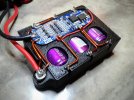
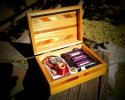
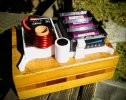
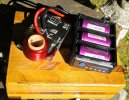
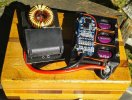

Witchcraft I tell you... WITCHCRAFT...!!!Just to complete my saga. This is the end of my half-pint wired project... don't ask me... I literally soldered some stuff while the box was closed. Tiny. Nice to hold while drawing. The tubing light (led on the bottom inserted in an silicone plug) gives help to know what's going on while this thing is in your face. So next challenge : HalfPint plus 1000mA LiPo-pack





Thank you for the questions. First of all, a discussion about 'switches' led to an idea I saw a long time ago and IIRC, it was deemed an excessive heat sink. I took the idea a little further and added compliance. An 'open switch' using the VC as a shunt. Little battery contact from old phones is a good way to get there. I had some contacts from an old build I could use. Be aware this may scratch colored caps. Not sure but don't want to forget to put that out there.Thank you so much tommydee for everything you put out! These experiments/builds/guides/tips&tricks are very appreciated! I am designing a 3D printed case for a 3S 18650 portable IH and want to use your latest thin HalfPint mod. A few questions if you don’t mind
In your latest post you teased us with a coil activated switch, can you explain how it works? Would that still work if the coil/glass is pointing “forward” in your boxtroll instead of how you have it now, pointing upwards?
How is your coil wrapped, how many turns and is it two layers of coil or am I seeing it wrong?
Also, do you know what to avoid/look for when buying ZVS modules? I’m buying from AliExpress/China.
Would it be possible to get a coil jig .stl for coil winding from you? Is it something similiar to this: https://www.thingiverse.com/thing:45450143D printer and a spindle to the rescue.
can someone link me to a wiring diagram on how to achieve this please!Well removing one inductor and one cap works great. I did 5 back to back tests with this configuration no problems. Saves space and saves buying a MOSFET switch.
I will buy this from youJust to complete my saga. This is the end of my half-pint wired project... don't ask me... I literally soldered some stuff while the box was closed. Tiny. Nice to hold while drawing. The tubing light (led on the bottom inserted in an silicone plug) gives help to know what's going on while this thing is in your face. So next challenge : HalfPint plus 1000mA LiPo-pack





I'm here too brother!I saw this just a bit ago. I thought it was a cool idea and if the idea was fine tuned I could see it going somewhere.
https://www.reddit.com/r/vaporents/comments/ka9rkh
Haha heck yeah. No problem I like the idea behind it.I'm here too brother!
InductionVap - Dual use induction powered vaporizer
Hey Everyone, Finally decided to make an account and post, been lurking around here for a bit! A lot of inspiration for this device came from these threads. I'd like to walk you all through the current version of an induction powered vaporizer made from easily (hopefully) sourced parts. I...fuckcombustion.com
Appreciate the shout out
You could make the head quite a bit smaller if you wanted.
I love the concepts but the size is problematic. There is an opportunity to put only the coil and the black capacitor near the bowl. The connecting leads need to be sizable, and they need to run nearly parallel and close together, but they can be be conventional 12 gauge wire pair. The circuit board and inductors can remain remote. Limit the lead-length, of course. The lead-wires are still part of the active inductive circuit. That is why the lead-wire pair needs to run close together. Look at silicone hobby wire for flexibility.
Theory behind this - the work of the IH is done with a signal bouncing back and forth between the capacitor and the work coil. That is where all the high current happens. The feed-circuit, the energy stored in the inductors, is buffered by the inductors themselves stretching out the time domain. The capacitor's discharge is nearly instantaneous and is the reason for the high current pulse directly into a 1uh inductor, a virtual short circuit. Pay attention and you can fashion a nice little heater-head with a remote circuit box.

